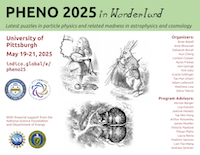Speaker
Description
The growth of large-scale structure in the early universe remains unexplained to this day. Originally proposed by Alan Guth, inflation, which posits a brief period of rapid cosmological growth, stands as a potential explanation to this puzzle. Inflationary models use “slow roll parameters” to align predictions with cosmological constraints fixed by data from the CMB and other such experiments. Due to the constraining nature of slow roll parameters, most inflationary models are only testable at energies far from the reach of particle colliders. However, recently Yang Bai and Daniel Stolarski have proposed an interesting new inflationary model with energies falling within the detection range of current and upcoming particle colliders. We introduce a minimal setup to achieve dynamical inflection point inflation, utilizing a minimal framework. Our approach examines collider constraints on inflationary parameters using the same field composition. Specifically, we incorporate an dark SU(2)D gauge sector featuring a dark scalar doublet as the inflaton, accompanied by particle content akin to the Standard Model but with degenerate masses. This configuration facilitates the realization of multiple inflection points in the inflaton potential. Notably, all vector-like particles in the exotic content possess identical Standard Model charges, enabling the inflaton's decay into the visible sector for reheating the universe. Our study establishes a vital link between collider constraints and their implications on inflationary parameters.

